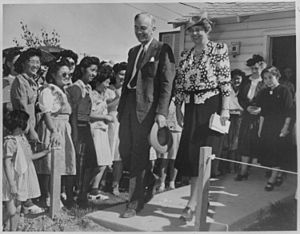Arizona during World War II facts for kids
Quick facts for kids Arizona during World War II |
|
|---|---|

First Lady Eleanor Roosevelt and Dillon S. Myer visit the Gila River War Relocation Center (April 23, 1943)
|
|
| Location | Arizona, United States |
| Date | 1940–1945 |
| Casualties | ~2,349 |
| Events | Machita Incident – October 16, 1940 Thanksgiving Day /Phoenix Massacre – November 27, 1942 Great Papago Escape – December 23, 1944 |
When World War II began, Arizona played a big role in helping the United States prepare for battle. Starting in 1940, the U.S. government built many military bases across the state. Arizona helped the Allied forces in many ways. It provided soldiers and important facilities.
During the war, Arizona also had prisoner of war camps. These were located at Camp Florence and Papago Park. There was also a special camp for Japanese-Americans. Many of these people were U.S. citizens. They were forced to move from the West Coast to these camps.
The war years brought a lot of economic growth to Arizona. Many troops were stationed in the state. There was also a huge demand for materials like copper and other metals. Industries grew, which helped Arizona recover from the Great Depression.
Contents
How Arizona Helped in WWII
Arizona's warm weather and wide-open spaces made it perfect for training soldiers. Many airfields and training centers were built here. Pilots learned to fly, and soldiers practiced their skills. This training was very important for the war effort.
Arizona's People Join the Fight
Thousands of Arizonans joined the military. They served in all branches, including the Army, Navy, and Air Force. These brave men and women fought in battles around the world. They helped protect freedom and peace.
Hispanics Support the War
Mexican-American communities in Arizona strongly supported the war. Local groups worked hard to help American troops. They raised money and collected supplies. They also gave moral support to young soldiers, especially those from their own communities.
Many projects involved both Anglo and Hispanic communities. But most efforts were led by Mexican-Americans themselves. Mexican-American women also played a huge part. For example, the Spanish-American Mothers and Wives Association in Tucson helped their servicemen. They raised thousands of dollars and wrote letters to soldiers. This group had over 300 members during the war.
Prisoner of War Camps in Arizona
Arizona was home to several prisoner of war (POW) camps. These camps held enemy soldiers captured during the war.
Camp Florence
Camp Florence was the first permanent POW camp built in the U.S. during World War II. Construction started in 1942. It was designed to hold 3,000 prisoners, with room to expand to 6,000. The U.S. Army used it to house captured enemy soldiers.
Papago Park Camp
Another important POW camp was located at Papago Park near Phoenix. This camp held many German prisoners of war. It was known for a famous escape attempt.
Casualties from Arizona
Sadly, many Arizonans lost their lives during World War II. About 2,349 people from Arizona died serving their country. These brave individuals made the ultimate sacrifice for freedom.
Gallery
-
Eight Arizonans were killed aboard USS Arizona during the attack on Pearl Harbor.
-
Ira Hayes (Pima) from Sacaton preparing to parachute in 1943. He was famous for raising the American flag on Mount Suribachi during the Battle of Iwo Jima.
See Also
- List of World War II prisoner-of-war camps in the United States










